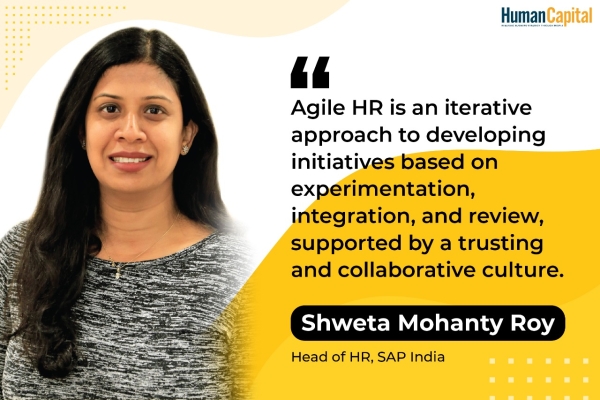“For any Organisational culture to succeed, it is imperative to acknowledge that diversity is not possible unless there are conditions for inclusion. Inclusion comes first, and diversity is the result of those inclusive conditions.”
In a candid conversation about the forever changing landscape of work, Shweta Mohanty Roy, Head of HR, SAP India, opened up about adopting an agile mindset within the HR function, and how it can help scale practices across functions. She also elaborated on the essential cultural change required to move from a microcosm of various cultures within an Organisation–and how it was possible to achieve this for an Organisation of any size.
What is the key to a successful CEO-CHRO relationship?
The CEO-CHRO relationship is quite possibly of the most unpredictable relationship today. CHROs are one of the significant c-suite accomplices for CEOs to drive the discussions around labor force, ability advancement, social developments, and generally speaking authoritative supportability. With the attention on ability, the association of CEOs and CHROs are progressively basic to guarantee Organizations are addressing one voice for individuals and empower business technique.
The CEO-CHRO relationship is the one that releases the Organization’s energy and its collaboration, particularly while allocating ability to connect holes, especially for individuals who will be drivers of the change and development for an association.
To have the most useful associations with CEOs, CHROs ought to endeavor to be reasonable specialists and adjust on a common vision and business technique. Moreover, having an impartial assessment and adding to different issues can prompt them becoming significant consultants to the CEO on a great many points. At long last, they ought to give an elevated perspective on the business, i.e., talk with the CEO on where the business is presently and where it ought to be in at least one business cycles.
How can HR and business leaders bring a cultural change that sticks when each Organisation is said to have a microcosm of cultures?
The microcosm of societies is something that brews over a period. For any Organizational culture to succeed, it is basic to recognize that variety is unimaginable except if there are conditions for consideration. Incorporation starts things out, and variety is the aftereffect of those comprehensive circumstances. To support and encourage consideration, pioneers should lead from the front. Consequently, bringing a social change when there is a microcosm of societies is fundamental. We do this by adopting a functioning strategy: we work with the chief group and different partners across the organization to evaluate the holes and open doors and make a brilliant course of action, so the normal culture is laid out.
It is additionally about adjusting our enrollment objectives, being bosses of variety and incorporation, where everybody is gladly received – this welcomes the right ability ready, which drives the social change required.
Moreover, HR and business pioneers can guarantee that workers have the apparatuses to help the organization culture by guaranteeing see everything through to completion. This incorporates fostering a hearty ability the board program, integrating society into representative correspondence, going about as culture good examples, deliberately displaying wanted ways of behaving, and so on. We can guarantee successful yet feasible social change by executing these means together in an Organization with a microcosm of societies present.
Which, according to you, are the most important skill sets needed for an employee to re-enter the workforce?
When we think about talent, we consider a few things like how to access talent, how do you get it, how do you become a creator of talent, and how do you help them maximize their potential? The ability to learn, or learning agility, is the most important thing we look for, regardless of who we are. Because we recognize that, while any Organisation may hire a person for a specific set of skills, the rate of change and skill demand is quite rapid. If you are looking to re-enter the workforce, it is best to upskill or ensure to stay skilled. The demand for qualified employees has become non-negotiable, particularly since the pandemic. Not to mention how Organisations are constantly engaging and investing in employee skilling, re-skilling, and upskilling. Taking the time to fill skill gaps also demonstrates ambition and gives people a competitive edge throughout their careers in a hot labor market.
Leaders usually have packed schedules, and self-care often falls by the wayside during the daily grind. What simple selfcare practices can leaders use even on their busiest days to restore depleted energy levels?
Stress is frequently a side-effect of cutthroat work areas, and outrageous, steady tensions can prompt the debilitating condition known as burnout. Furthermore, this is material to pioneers as well.
The best practice applied at SAP is focusing on your wellbeing. We urge individuals to move their viewpoint to figure out which parts of their circumstance are fixed and which can be changed, restricting their openness to the most distressing exercises and connections and looking for supportive relational associations.
Moreover, set aside a few minutes for companions, get sufficient rest, focus on quality dinners, and keep an equilibrium of relaxation time in your timetable. Besides, having a selfpampering experience is a straightforward yet frequently disregarded type of selfcare.
How would you articulate your view on “Agile HR” and your role in the Agile journey at SAP?
Spry HR is an iterative way to deal with creating drives in view of trial and error, mix, and survey, upheld by a trusting and cooperative culture. Dexterous started in programming advancement, however the lithe mentality and standards are progressively being tried in HR. Coordinated is a technique in the HR world that regularly focuses on responsiveness and versatility.
At SAP, we continually ask how HR can function in more limited circles? How might we foster HR Practices iteratively and steadily? How might we function in cross-utilitarian groups, and above all, how might we make HR more representative driven?
At SAP, we gather worker criticism, and a large number of our HR strategies and practices are created base up, subsequently guaranteeing that representatives play a part to play there. We were dependably mindful of altering specific practices to integrate a deft approach to working into HR business processes. For example, one of the principal things we changed was the way we led representative overviews. We used to lead a conventional overview with a counseling firm one time each year, and individuals consumed a large chunk of the day to answer. If you have any desire to be coordinated today, you should have moment criticism. You should likewise have the option to answer rapidly to criticism.
Likewise, we embraced dexterity for our objective setting processes. We laid out quarterly objective setting in the group and individual level to drive more prominent responsibility and concentration, straightforwardly connected to ability improvement and prizes. Our representative improvement plan is a respective cycle where the onus is on the workers to characterize and shape their professions, with the chief going about as a facilitator. Workers put forth their objectives on two perspectives – business objectives in view of SAP’s needs and improvement objectives to design the subsequent stages in a representative’s vocation.




